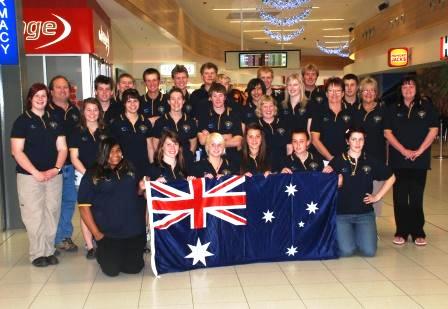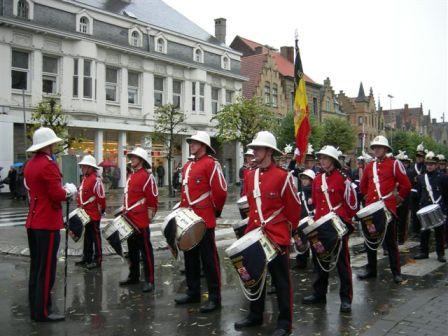Ninety six years ago, on 14th September 1914, the newly commissioned Royal Australian Navy submarine, the AE1, was lost with all hands aboard perishing.
The AE1 and the AE2 were launched in May 1913 and commissioned into the Australian Navy in the United Kingdom on 28 February 1914.
 Photo: Royal Australian Navy submarine AE1
Photo: Royal Australian Navy submarine AE1
[Australian Department of Defence]
The Australian War Memorial states: At the outbreak of the First World War, the AE1 and the AE2 were sent from Sydney to German New Guinea with the Australian Naval & Military Expeditionary Force and helped to capture the German colony. On 14 September, a day after the official German surrender of the colony, the AE1, commanded by Lieutenant Commander Thomas Besant, left Rabaul harbour to patrol Cape Gazelle, and never returned. The fate of the submarine was never known, but it is probable that the submarine was caught on a coral reef and sunk.
Present day members of the Australian Defence Forces paused during a recent deployment to Rabaul, Papua New Guinea as part of Pacific Partnership 2010 to allow the ship’s company and embarked forces onboard HMAS Tobruk to remember the lost submariners of AE1. The chance to honour the sailors so close to their last known position was a special event for the Australian Defence Force personnel onboard Tobruk.
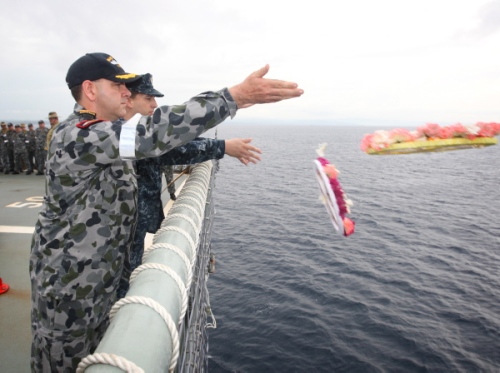 Photo: Commanding Officer HMAS Tobruk, Commander Paul Scott (left) and United States Navy Lieutenant Commander Bill Lance (back left) lay wreaths in waters off the coast of Duke of York Islands during a memorial service for the loss of AE1.
Photo: Commanding Officer HMAS Tobruk, Commander Paul Scott (left) and United States Navy Lieutenant Commander Bill Lance (back left) lay wreaths in waters off the coast of Duke of York Islands during a memorial service for the loss of AE1.
[Australian Department of Defence]
The following press release was issued by the Department of Defence: HMAS Tobruk sailors pause to remember lost WWI submariners
HMAS Tobruk Ship’s Company and embarked forces have commemorated the 96th anniversary of the loss of Australian World War I submarine AE1 and its 35 man crew on 14 September 1914, by laying wreaths at sea.
The ceremony was held on 11 September as Tobruk passed through the last known position of the AE1, following a recent deployment to Rabaul, Papua New Guinea as part of Pacific Partnership 213010.
“The opportunity to honour these sailors so close to their last known position was a special event for the Australian Defence Force personnel onboard Tobruk, said Commanding Officer, Commander Paul Scott.
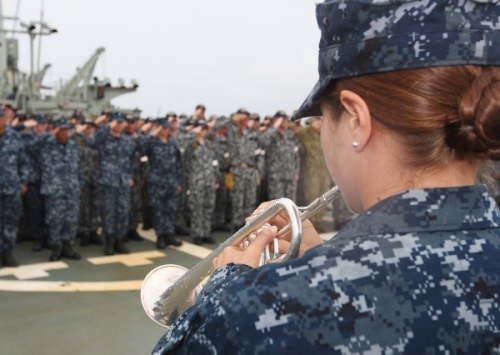 Photo: Musician 3rd Class Colleen Cave sounds the last post as Australian Defence Force, United States Navy and Papua New Guinea Defence Force members salute in honour of the men of AE1 who were lost with all hands in the vicinity of Duke of York Islands during a memorial service on the flight deck of HMAS Tobruk.
Photo: Musician 3rd Class Colleen Cave sounds the last post as Australian Defence Force, United States Navy and Papua New Guinea Defence Force members salute in honour of the men of AE1 who were lost with all hands in the vicinity of Duke of York Islands during a memorial service on the flight deck of HMAS Tobruk.
[Australian Department of Defence]
“The men of AE1, along with the sailors and Officers of AE2 had completed the longest journey ever conducted by a Submarine at the time when they delivered the newly built boats to Sydney from England. Not long after, the crew of AE1 was sent to Rabaul as part of Australia’s World War I effort against the German Pacific Fleet: where they went missing,” Commander Scott said.
“The sea remains an unforgiving, dangerous environment, even more so during war. The chance to honour our first generation of Submariners in this way is particularly poignant; their exact location may be unknown but their contribution and sacrifices will not be forgotten.”
The memory of the tragedy is especially hard for the families of the lost submariners said AE1 Incorporated spokesperson Dr Kathyrn Spurling.
“For generations of relatives of the 35 crew there has been no closure. We need to honour these men for their service and sacrifice and this means finding AE1 and resolving how they died,” she said.
“The disappearance of AE1 was Australia’s first naval tragedy and the 96 year old mystery remains unresolved.” Dr Spurling said.
*****
Amongst the 35 crew members who were lost was 1138 Able Seaman Jack Jarman from St Kilda, Melbourne Victoria.
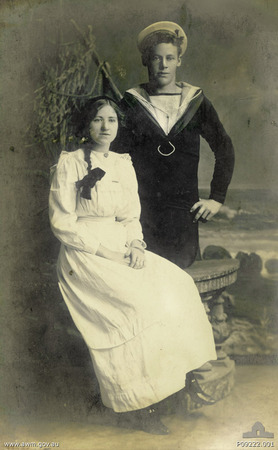 Photo: Able Seaman Jack Jarman
Photo: Able Seaman Jack Jarman
with a young woman thought to be his sister.
[AWM P09222.001]
Jack Jarman was born on 11th June 1893 in Dookie, Victoria and was eighteen years old when he enlisted in the Royal Australian Navy for 5 years service in May 1911. At 5’ 81/2” Jack would have presented a very impressive figure as a sailor with his service record stating that he was already sporting a number of tattoos including:
R.arm. Nellie over clasped hands. 3 horseshoes, heart and cross, ship in wreath. L.arm. Full rigged ship. Shield and heart. Floral design on left hand.
Jack was part of the original crew of combined English and Australian men who sailed the AE1 and the AE2 from England to Australia in early 1914. Jack was 21 years old when he perished at sea.
LEST WE FORGET
*****
The Families and Friends of the First AIF applauds the joint Australian–UK decision, to conduct a full DNA testing program on the remains of Australian and British soldiers found in mass graves at Pheasant Wood (Fromelles), and for their continuing commitment to identify as many of the fallen as is possible. We also thank the Australian, UK and French governments for affording dignified individual reburials for these soldiers, buried by German soldiers following the Battle of Fromelles on 19/20 July 1916, in the new Fromelles (Pheasant Wood) Military Cemetery.
Read Full Post »
